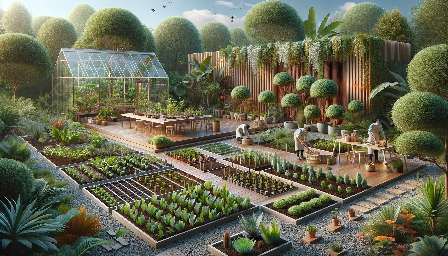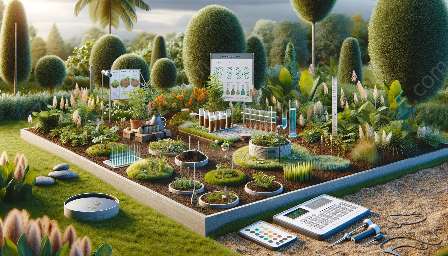Sustainable agriculture represents a paradigm shift in our approach to cultivating crops and raising livestock. This holistic method prioritizes environmental health, economic profitability, and social equity, offering a potentially brighter future for generations to come. In this comprehensive guide, we will explore the concept of sustainable agriculture and its compatibility with horticulture, agriculture, and forestry. We will delve into sustainable practices, environmental benefits, and modern techniques aimed at promoting a more resilient and harmonious relationship between agriculture and the natural world.
Sustainable Agriculture and Horticulture
Sustainable agriculture and horticulture are intimately linked, as both disciplines seek to cultivate and propagate plants in a way that respects the environment and maximizes long-term benefits. The principles of sustainable agriculture, such as crop rotation, organic pest control, and soil conservation, find direct application in horticultural practices. In sustainable horticulture, the focus is on minimizing the use of synthetic inputs, conserving water resources, and promoting biodiversity through the selection of native and resilient plant species. By integrating sustainable agriculture principles into horticultural techniques, growers can enhance the health and productivity of their crops while minimizing negative impacts on the surrounding ecosystem.
Sustainable Agriculture, Agriculture, and Forestry
Sustainable agriculture also shares common ground with traditional agriculture and forestry, as it seeks to balance the needs of production with those of environmental preservation. Through sustainable agriculture, farmers and foresters can adopt agroforestry practices, which integrate trees and shrubs into agricultural landscapes to enhance ecosystem services, increase biodiversity, and improve soil health. Moreover, sustainable agriculture offers novel techniques for reducing the environmental footprint of traditional agricultural activities, such as precision agriculture, which employs technology to optimize input use and minimize waste. By embracing sustainable agriculture principles, the agricultural and forestry sectors can work towards a more sustainable and resilient future without compromising productivity.
Principles of Sustainable Agriculture
The principles of sustainable agriculture encompass a diverse range of practices that aim to enhance environmental sustainability, economic viability, and social well-being. Some core principles include:
- Crop Rotation: By rotating crops in a regular sequence, farmers can minimize soil erosion, prevent pest and disease buildup, and improve soil fertility. Additionally, diverse crop rotations can enhance ecosystem services and biodiversity.
- Organic Pest Control: Utilizing natural predators, crop diversity, and biological controls, sustainable agriculture seeks to manage pests and diseases without relying on harmful synthetic chemicals.
- Water Conservation: Through the implementation of efficient irrigation systems, soil moisture monitoring, and drought-tolerant crop varieties, sustainable agriculture aims to minimize water usage and protect water resources.
- Soil Conservation: By employing conservation tillage, cover cropping, and agroforestry, sustainable agriculture safeguards soil health, reduces erosion, and preserves the integrity of the land.
Environmental Benefits of Sustainable Agriculture
Sustainable agriculture offers a multitude of environmental benefits, including:
- Biodiversity Conservation: By promoting diverse ecosystems and minimizing chemical inputs, sustainable agriculture supports the preservation of native flora and fauna, contributing to enhanced biodiversity and ecosystem resilience.
- Climate Mitigation: Through the sequestration of carbon in soils and vegetation, sustainable agriculture helps mitigate climate change by reducing greenhouse gas emissions and enhancing carbon storage capacity.
- Water Quality Improvement: By minimizing nutrient runoff and adopting practices that protect soil and water resources, sustainable agriculture contributes to improved water quality and reduced pollution of aquatic ecosystems.
- Reduced Input Dependency: Sustainable agriculture reduces reliance on synthetic fertilizers, pesticides, and herbicides, diminishing the negative impact of chemical inputs on the surrounding environment and human health.
Modern Techniques in Sustainable Agriculture
Advancements in science, technology, and agricultural practices have led to the development of modern techniques that align with the principles of sustainable agriculture. Some notable innovations include:
- Precision Agriculture: Utilizing data-driven technologies, such as GPS-guided machinery and remote sensing, precision agriculture enables farmers to optimize resource use, minimize input waste, and increase operational efficiency.
- Agroecology: By integrating ecological principles and biological interactions, agroecological approaches promote sustainable farming systems that are resilient, diverse, and harmonious with natural ecosystems.
- Vertical Farming: With the use of controlled environment agriculture (CEA) technologies, vertical farming allows for the efficient production of crops in vertically stacked layers, conserving space, water, and energy while minimizing transportation emissions.
- Regenerative Agriculture: Emphasizing soil health, biodiversity, and carbon sequestration, regenerative agriculture practices aim to restore and enhance the natural resources and ecological processes that underpin agricultural productivity.
Conclusion
Sustainable agriculture offers a promising pathway towards a more resilient, regenerative, and equitable food system. By integrating sustainable principles into horticulture, agriculture, and forestry, we can foster the development of thriving ecosystems, economically viable farming operations, and healthier communities. Embracing sustainable agriculture not only safeguards the environment and natural resources but also nurtures a sustainable livelihood for current and future generations.



